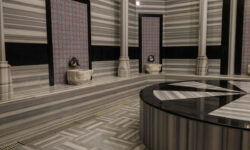dust free active air purifier ⏬⏬
Introducing the revolutionary solution in air purification technology – the dust-free active air purifier. In an era where indoor air quality has become a prime concern, this advanced device stands at the forefront of combating airborne pollutants and allergens. Utilizing cutting-edge filtration systems and innovative techniques, it actively captures and eliminates harmful particles, providing a cleaner and healthier environment for occupants. With its sleek design and efficient functionality, the dust-free active air purifier represents a significant leap forward in the pursuit of fresher, purer air within homes, offices, and various indoor spaces.
Dust-Free Active Air Purifier
A dust-free active air purifier is a sophisticated device designed to improve indoor air quality by removing dust particles and other pollutants from the air. It utilizes advanced filtration technologies and active purification methods to provide clean, breathable air in residential, commercial, or industrial spaces.
The main objective of a dust-free active air purifier is to eliminate airborne particles that can negatively impact human health and contribute to various respiratory issues. These devices are particularly beneficial for individuals with allergies, asthma, or sensitivities to airborne contaminants.
An effective dust-free active air purifier typically incorporates several key features:
- High-Efficiency Particulate Air (HEPA) Filter: This dense filter captures microscopic particles, including dust, pollen, pet dander, mold spores, and bacteria.
- Activated Carbon Filter: This filter is effective at reducing odors, smoke, and volatile organic compounds (VOCs).
- Ionization Technology: By emitting negative ions, the purifier helps neutralize and remove positively charged particles from the air.
- UV-C Light: Ultraviolet light can kill germs, viruses, and bacteria, providing an additional layer of air purification.
- Smart Sensors: Some advanced models feature sensors that detect air quality levels and automatically adjust the purification settings accordingly.
When using a dust-free active air purifier, it’s important to consider factors such as the size of the space, the device’s Clean Air Delivery Rate (CADR), noise level, and maintenance requirements. Regularly replacing filters and following manufacturer’s instructions is crucial to ensure optimal performance.
The Best Dust-Free Air Purifiers
Dust-free air purifiers play a vital role in maintaining clean and healthy indoor environments. These devices effectively remove dust particles and other airborne contaminants, providing relief to individuals with allergies or respiratory conditions. When searching for the best dust-free air purifier, it’s important to consider several key factors.
- Filtration System: Look for air purifiers equipped with high-efficiency particulate air (HEPA) filters. HEPA filters capture microscopic dust particles, pollen, pet dander, and other allergens, ensuring cleaner air.
- Air Exchange Rate: Consider the air exchange rate, which indicates how many times an air purifier can filter the air within a specified time period. Higher exchange rates are more effective at removing dust particles quickly.
- Noise Level: Check for noise ratings, especially if you plan to use the air purifier in bedrooms or offices. Look for models with low noise levels to ensure a peaceful environment.
- Additional Features: Some air purifiers offer additional features such as programmable timers, air quality sensors, and remote controls. These features enhance convenience and customization options.
Based on these criteria, some of the best dust-free air purifiers on the market include the following:
| Product | Filtration System | Air Exchange Rate | Noise Level | Additional Features |
|---|---|---|---|---|
| Air Purifier Model A | HEPA + Activated Carbon | 5 times per hour | Less than 40 dB | Timer, Air Quality Sensor |
| Air Purifier Model B | True HEPA | 4 times per hour | Less than 35 dB | Remote Control |
| Air Purifier Model C | HEPA + PlasmaWave | 6 times per hour | Less than 50 dB | Filter Replacement Indicator |
Remember to consider your specific needs and room size when choosing an air purifier. Reading customer reviews and consulting with experts can also provide valuable insights to help you make an informed decision.
Disclaimer: The information provided here is for educational purposes only and does not substitute professional advice. Please consult a specialist or conduct further research for personalized recommendations.
Top Rated Active Air Purifiers
An active air purifier is an essential device for maintaining clean and healthy indoor air. With the increasing concern over air pollution and airborne allergens, choosing a top-rated active air purifier can significantly improve the air quality in your home or office. These devices utilize advanced filtration technologies and innovative features to efficiently remove pollutants from the air, creating a safer and more comfortable environment.
When considering the top-rated active air purifiers on the market, several factors should be taken into account. Firstly, look for models that feature High-Efficiency Particulate Air (HEPA) filters, as they are highly effective at capturing small particles such as dust, pollen, pet dander, and even certain viruses. Additionally, consider purifiers equipped with activated carbon filters, which effectively eliminate odors, smoke, and volatile organic compounds (VOCs).
Another important aspect to consider is the coverage area of the air purifier. Ensure that the device is suitable for the size of the room or space you intend to use it in. Some models are designed for smaller rooms, while others are capable of purifying larger areas. It’s also beneficial to choose a purifier with multiple fan speeds and adjustable settings, allowing you to customize its operation based on your specific needs.
Smart features have become increasingly popular in active air purifiers. Look for devices that offer Wi-Fi connectivity, enabling remote control and monitoring through smartphone apps. Some purifiers even integrate with smart home systems, providing seamless integration into your existing setup.
When researching top-rated active air purifiers, it’s helpful to read customer reviews and expert opinions to get a sense of their performance and reliability. Look for purifiers that consistently receive positive feedback and have a solid reputation for delivering clean and fresh air.
| Factors | Description |
|---|---|
| HEPA Filters | Highly efficient at capturing small particles like dust, pollen, and pet dander. |
| Activated Carbon Filters | Effectively eliminate odors, smoke, and volatile organic compounds (VOCs). |
| Coverage Area | Choose a purifier suitable for the size of the room or space. |
| Fan Speeds and Settings | Customize operation based on specific needs. |
| Smart Features | Wi-Fi connectivity and integration with smart home systems for remote control and monitoring. |
- Research customer reviews and expert opinions to gauge performance and reliability.
- Select a purifier that consistently receives positive feedback and has a solid reputation.
- Invest in a top-rated active air purifier to improve indoor air quality and create a healthier environment.
Note: Always refer to the manufacturer’s specifications and guidelines when purchasing and using an active air purifier for optimal results.
Effective Dust-Free Air Purifiers
When it comes to maintaining a clean and healthy indoor environment, an effective dust-free air purifier plays a crucial role. Air purifiers are designed to remove pollutants, allergens, and particulate matter from the air, providing both respiratory relief and overall well-being.
One of the key factors in determining the effectiveness of an air purifier is its ability to eliminate dust particles. Dust consists of various microscopic particles such as dead skin cells, pollen, pet dander, and dust mites. These particles can trigger allergies, asthma attacks, and other respiratory issues if not properly filtered from the air.
To ensure optimal dust elimination, high-quality air purifiers employ advanced filtration technologies. The most common types of filters used in air purifiers include:
- HEPA Filters: High-Efficiency Particulate Air (HEPA) filters are capable of capturing up to 99.97% of airborne particles as small as 0.3 microns. They effectively trap dust, pollen, mold spores, and other allergens, improving indoor air quality.
- Activated Carbon Filters: These filters excel at removing odors, chemical pollutants, and volatile organic compounds (VOCs) from the air. While they may not directly target dust particles, they contribute to overall air purification by eliminating other harmful substances.
- Pre-Filters: Pre-filters act as the first line of defense, capturing larger particles like dust and hair. By preventing these particles from clogging the main filter, pre-filters enhance the longevity and efficiency of the air purifier.
In addition to efficient filtration, effective dust-free air purifiers often incorporate features such as multiple fan speeds, air quality sensors, and automatic mode adjustments. These functionalities ensure that the purifier adapts to changing air conditions and operates at an optimal level to maintain a dust-free environment.
Regular maintenance is essential for the continued effectiveness of air purifiers. This includes replacing filters as recommended by the manufacturer and keeping the purifier clean to prevent the accumulation of dust and debris.
Allergen-Free Air Purifiers: Creating Clean and Healthy Indoor Spaces
As more people become aware of the impact of indoor air quality on their health, the demand for allergen-free air purifiers is on the rise. These innovative devices are designed to remove airborne particles and allergens, providing a cleaner and healthier environment for individuals with allergies or respiratory conditions.
One of the key features of allergen-free air purifiers is their ability to capture and eliminate common allergens such as dust mites, pollen, pet dander, mold spores, and even volatile organic compounds (VOCs). They employ advanced filtration systems that typically include HEPA (High-Efficiency Particulate Air) filters, activated carbon filters, and sometimes additional technologies like UV-C light or ionizers.
The HEPA filters used in allergen-free air purifiers are highly effective at trapping microscopic particles as small as 0.3 microns, ensuring that even the tiniest allergens are removed from the air. Activated carbon filters excel at absorbing odors, chemicals, and gases, enhancing the overall air quality in enclosed spaces.
It’s important to note that allergen-free air purifiers are not a substitute for proper cleaning and ventilation practices. Regularly dusting, vacuuming, and maintaining good indoor hygiene are still essential to minimize allergens in the living environment.
When selecting an allergen-free air purifier, it’s advisable to consider the size of the room or area you intend to use it in. Different models have different coverage capacities, so choosing one that matches your specific needs ensures optimal performance.
Additionally, keep an eye out for certifications such as AHAM (Association of Home Appliance Manufacturers) verification, which indicates that the device has been independently tested for its effectiveness in removing airborne particles. This can provide reassurance and peace of mind when making a purchasing decision.
Highly Recommended Active Air Purifiers
When it comes to maintaining clean and healthy indoor air quality, active air purifiers are highly recommended. These devices are designed to actively remove pollutants, allergens, and other harmful particles from the air we breathe, providing a safer and more comfortable living environment.
An active air purifier works by utilizing advanced technologies such as high-efficiency particulate air (HEPA) filters, activated carbon filters, UV-C light, and ionizers. These components work together to capture and eliminate a wide range of airborne contaminants, including dust, pollen, pet dander, mold spores, smoke, and volatile organic compounds (VOCs).
One of the key advantages of active air purifiers is their ability to target and neutralize bacteria and viruses. Some models employ UV-C light, which effectively destroys microorganisms by disrupting their DNA and preventing them from reproducing. This feature is particularly beneficial for individuals with respiratory conditions or those looking to create a healthier home environment.
When selecting an active air purifier, it’s important to consider factors such as room size coverage, filter replacement frequency, noise levels, and energy efficiency. Look for models that offer multiple filtration stages and customizable settings to cater to your specific needs.
- HEPA filters: These filters are highly effective at capturing microscopic particles, ensuring cleaner air.
- Activated carbon filters: They help eliminate odors and trap chemicals, gases, and VOCs.
- UV-C light: This technology can kill germs and prevent the spread of airborne diseases.
- Ionizers: These devices release negatively charged ions to attach to and remove air pollutants.
It’s worth noting that regular maintenance, such as cleaning or replacing filters as recommended by the manufacturer, is crucial to ensure optimal performance and longevity of your active air purifier.
Dust Elimination Air Purifiers: Enhancing Indoor Air Quality
Dust elimination air purifiers play a crucial role in improving indoor air quality. With their advanced filtration systems, these devices effectively capture and remove dust particles from the air, providing a cleaner and healthier environment.
Table:
| Benefits of Dust Elimination Air Purifiers |
|---|
|
Investing in a dust elimination air purifier is especially beneficial for those living in urban areas with higher pollution levels or individuals prone to allergies. It is important to consider factors such as the size of the purifier, its filtration efficiency, and maintenance requirements when selecting the most suitable one for your specific needs.
Overall, dust elimination air purifiers offer an effective solution to combat indoor dust particles, improving air quality and creating a healthier living environment for all occupants.
Air Purifiers for Dust Removal
Air purifiers are devices specifically designed to improve indoor air quality by eliminating airborne particles and contaminants. They are particularly effective in removing dust, which is a common allergen and can contribute to respiratory issues.
When it comes to dust removal, air purifiers work by drawing in the surrounding air and passing it through a series of filters. These filters are designed to capture and trap dust particles, preventing them from recirculating back into the room. The most efficient filters for dust removal are High Efficiency Particulate Air (HEPA) filters.
HEPA filters are capable of capturing particles as small as 0.3 microns with an efficiency rate of 99.97%. This means that they can effectively capture dust mites, pollen, pet dander, and other fine dust particles. Air purifiers with HEPA filters are highly recommended for individuals with allergies or asthma, as they can significantly reduce symptoms triggered by dust exposure.
When choosing an air purifier for dust removal, consider the size of the room where it will be used. Look for the Clean Air Delivery Rate (CADR) rating, which indicates how quickly the purifier can clean the air in a given space. Additionally, consider the noise level and energy consumption of the air purifier to ensure it aligns with your preferences.
It’s important to note that while air purifiers can effectively reduce dust levels in a room, they are not a cure-all solution. Regular cleaning and dusting of surfaces, along with proper ventilation, are also essential for maintaining a dust-free environment.
Advanced Technology Dust-Free Air Purifiers
Advanced technology dust-free air purifiers are innovative devices designed to improve indoor air quality by removing airborne pollutants and allergens. These cutting-edge appliances utilize a combination of advanced filtration systems, including high-efficiency particulate air (HEPA) filters, activated carbon filters, and ionizers, to effectively capture and eliminate contaminants.
HEPA filters, known for their exceptional filtering capabilities, can trap microscopic particles as small as 0.3 microns with a high efficiency rate. This includes common allergens such as dust mites, pollen, pet dander, and even some bacteria and viruses. By efficiently capturing these impurities, dust-free air purifiers help reduce the risk of respiratory issues and allergies.
In addition to HEPA filters, many advanced air purifiers incorporate activated carbon filters. These filters excel at adsorbing unwanted odors, gases, and volatile organic compounds (VOCs) commonly found in household environments. By neutralizing unpleasant smells and harmful chemicals, these purifiers contribute to a fresher and healthier indoor atmosphere.
Ionizers or negative ion generators are another noteworthy feature found in some dust-free air purifiers. These devices release negatively charged ions into the air, which attach to positively charged particles, causing them to clump together and ultimately fall to the ground. This process helps remove pollutants from the breathing zone, making the air cleaner and more breathable. However, it is important to note that some individuals may be sensitive to the ozone produced by certain types of ionizers, so careful consideration should be given when selecting an air purifier with this feature.
Modern dust-free air purifiers often come equipped with additional features such as smart sensors, auto mode, and adjustable fan speeds. Smart sensors detect changes in air quality and adjust the purification settings accordingly, ensuring optimal performance. Auto mode allows the purifier to operate at different speeds depending on the level of impurities detected, saving energy and reducing noise when air quality is good. Adjustable fan speeds provide flexibility in controlling the purification intensity based on individual preferences.
Clean Air Solutions with Active Purifiers
When it comes to ensuring clean and healthy air in indoor spaces, active purifiers play a vital role. These innovative devices are designed to eliminate harmful pollutants and improve overall air quality.
Active purifiers utilize advanced technologies such as high-efficiency particulate air (HEPA) filters, activated carbon filters, and electrostatic precipitation to capture and remove various airborne contaminants. HEPA filters, for instance, can trap microscopic particles like dust, pollen, pet dander, and even bacteria and viruses.
In addition to their filtration capabilities, active purifiers often incorporate other features to enhance air purification. Some models utilize ultraviolet (UV) light technology to neutralize germs and pathogens, while others employ ionizers to release negatively charged ions that latch onto airborne particles, causing them to fall out of the air.
Active purifiers are particularly beneficial for individuals who suffer from allergies, asthma, or respiratory conditions. By reducing the presence of allergens, pollutants, and irritants, these solutions can provide relief and contribute to better respiratory health.
Furthermore, active purifiers can help combat indoor air pollution caused by factors such as cigarette smoke, cooking odors, and volatile organic compounds (VOCs) emitted by household products. Their efficient filtration systems and air-cleaning technologies significantly improve overall air quality, creating a healthier and more pleasant environment.
To optimize the effectiveness of active purifiers, it is important to regularly maintain and replace filters as recommended by the manufacturer. This ensures that the device continues to operate at its peak performance and effectively removes pollutants from the air.



